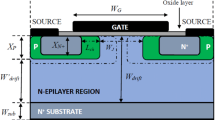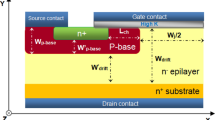Abstract
The carbon vacancy in 4H-SiC is an important recombination center of the minority carrier and a direct consequence of SiC-based device degradation. In 4H-SiC, this defect acts as the primary carrier-lifetime killer. Whether, low-energy electron radiation exposure or high temperature processing in an inert ambient gas will produce the carbon vacancy defect. Despite, the extensiveness of the studies concerning the defect’s modeling and characterization, numerous essential questions remain. Amongst them, we have the impact of these defects on the performance of 4H-SiC MOSFET. Herein, the influence of intrinsic defect states, namely, Z1/2 and EH6/7 centers, on the 4H-SiC MOSFET electrical outputs is examined via 2D numerical simulation. The obtained results show that the traps act to increase the device on-state resistance (RON), reduce the channel mobility, increase the threshold voltage (Vth). Besides, the increase of the temperature leads to less influence of the traps on the threshold variation. Furthermore, due to their locations in the bandgap, the impact of both Z1/2 and EH6/7 centers at room temperature on the device electrical outputs is extreme. For high temperature the EH6/7 have the severest impact because of the cross section temperature dependency.
Similar content being viewed by others
Data Availability
Data sharing not applicable
References
Baliga BJ (2005) Silicon Carbide Power Devices. World Scientific
ROHM Model SCT2H12NZ (1700V) (2018) Accessed: Jun. 2018. [Online]. Available: http://www.rohm.com/web/eu/products/-/product/ SCT2H12NZ
CREE Model C3M0280090D (900V) (2018) Accessed: Jun. 2018. [Online]. Available: http://www.wolfspeed.com/c3m0280090d
ROHM Model SCT3017AL (650V) (2018). Accessed: Jun. 2018. [Online]. Available: http://www.rohm.com/web/eu/products/-/product/SCT3017AL
Corte FGD, De Martino G, Pezzimenti F, Adinolfi G, Graditi G (2018). IEEE Trans Electron Dev 65:3352–3360
De Martino G, Pezzimenti F, Della Corte FG, Adinolfi G, Graditi G (2017) In Proc. IEEE Int. Conf. Ph. D. Research in Microelectronics and Electronics - PRIME, 221–224
Khan O, Xiao W, El Moursi MS (2016). IEEE Trans Power Electron 32:3278–3284
Zhou H, Zhao J, Han Y (2014). IEEE Trans Power Electron 30:3479–3487
Graditi G, Adinolfi G, Tina GM (2014). Appl Energy 115:140–150
Bencherif H, Pezzimenti F, Dehimi L, De Martino G, Corte FGD (2020). Appl Phys A-Mater. https://doi.org/10.1007/s00339-020-03850-6
Hemmingsson CG, Son NT, Ellison A, Zhang J, Janz_en E (1998) Phys Rev B 58:R10119
Klein PB (2008). J Appl Phys 103:033702
Son NT, Trinh XT, Løvlie LS, Svensson BG, Kawahara K, Suda J, Kimoto T, Umeda T, Isoya J, Makino T, Ohshima T, Janz_en E (2012) Phys Rev Lett 109:187603
Trinh XT, Sz_asz K, Hornos T, Kawahara K, Suda J, Kimoto T, Gali A, Janz_en E, Son NT (2013) Phys Rev B 88:235209
Bencherif H, Yousfi A, Dehimi L, Pezzimenti F, Della Corte FG (2019) In Proc. IEEE Inter. Conf. on Sustainable Renewable Energy Systems and Applications – ICSRESA pp. 1–4
Bencherif H, Dehimi L, Pezzimenti F, De Martino G, Della Corte FG (2019). J Electron Mater 48:3871–3880
Bencherif H, Dehimi L, Pezzimenti F, Yousfi A, De Martino G, Della Corte FG (2019) In Proc. IEEE Inter. Conf. on Advanced Electrical Engineering – ICAEE pp. 1–4
Umeda T, Isoya J, Morishita N, Ohshima T, Kamiya T (2004). Phys Rev B 69:121201
Zywietz A, Furthm€uller J, Bechstedt F (1999). Phys Rev B 59:15166
Torpo L, Marlo M, Staab TEM, Nieminen RM (2001). J Phys Condens Matter 13:6203
Bockstedte M, Marini A, Pankratov O, Rubio A (2010). Phys Rev Lett 105:026401
Bencherif H, Dehimi L, Pezzimenti F, Della Corte FG (2019). Appl Phys A-Mater 125:294
Storasta L, Tsuchida H (2007). Appl Phys Lett 90:062116
Storasta L, Tsuchida H, Miyazawa T, Ohshima T (2008). J Appl Phys 103:013705
Hiyoshi T, Kimoto T (2009). Appl Phys Express 2:041101
Hiyoshi T, Kimoto T (2009). Appl. Phys. Express 2:091101
Ayedh HM, Nipoti R, Hallen A, Svensson BG (2015). Appl Phys Lett 107:252102
Sung W, Baliga BJ (2016). IEEE Electron Device Letters 37:1605–1608
Mikamura Y, Hiratsuka K, Tsuno T, Michikoshi H, Tanaka S, Masuda T, Sekiguchi T (2014). IEEE Trans Electron Dev 62:382–389
Okamoto M, Iijima M, Nagano T, Fukuda K, Okumura H (2012). Mater Science Forum 717:781–784
Silvaco Int. (2013) Atlas User’s Manual, Device Simulator Software
Baliga BJ (2005) Silicon Carbide Power Devices. World Scientific, Singapore
Raghunathan R, Baliga BJ (1997) Proc IEEE ISPSD’97, 173–176
Ruff M, Mitlehner H, Helbig R (1994) 41, 1040–1054
Lindefelt U (1998). J Appl Phys 84:2628–2637
Lombardi C, Manzini S, Saporito A, Vanzi M (1992). IEEE Trans Comp Aided Design 7:1154–1171
Roschke M, Schwierz F (2001). IEEE Trans Electron Devices 48:1442–1447
Pezzimenti F (2013). IEEE Trans Electron Devices 60:1404–1411
Bellone S, Corte FGD, Freda Albanese L, Pezzimenti F (2011). IEEE Trans Power Electron 26:2835–2843
Megherbi ML, Pezzimenti F, Dehimi L, Saadoune MA, Della Corte FG (2018). IEEE Trans Electron Devices 65(8):3371–3378
Pezzimenti F, Corte FGD, Nipoti R (2008). Microelectronics J 39:1594–1599
Corte FGD, Pezzimenti F, Nipoti R (2007). Microelectronics J 38:1273–1279
Dalibor T, Pensl G, Matsunami H, Kimoto T, Choyke WJ, Schöner A, Nordell N (1997). Phys Stat Sol A 162:199–225
Klein PB, Shanabrook BV, Huh SW, Polyakov AY, Skowronski M, Sumakeris JJ, O'Loughlin MJ (2006). Appl Phys Lett 88:052110
Danno K, Nakamura D, Kimoto T (2007). Appl Phys Lett 90:202109
Son NT, Trinh XT, Lovlie LS, Svensson BG, Kawahara K, Suda J, Kimoto T, Umeda T, Isoya J, Makino T, Ohshima T, Janzén E (2012). Phys Rev Lett 109:187603
Booker ID, Janzén E, Son NT, Hassan J, Stenberg P, Sveinbjörnsson EÖ (2016). Appl Phys 119:235703
Hemmingsson CG, Son NT, Ellison A, Zhang J, Janzén E (1998) Negative-U centers in 4H silicon carbide. Phys Rev B 58:R10119
Hemmingsson C, Son NT, Kordina O, Bergman JP, Janzén E, Lindström JL, Savage S, Nordell N (1997). J Appl Phys 81:6155–6159
Danno K, Kimoto T (2006). J Appl Phys 100:113728
Hornos T, Gali A, Svensson BG (2011) Negative-U system of carbon vacancy in 4H-SiC. Mater Sci Forum 679–680:261–264
Kawahara K, Trinh XT, Son NT, Janzen E, Suda J, Kimoto T (2014). J Appl Phys 115:143705
Feng ZC, Zhao JH (2004) Silicon Carbide: Materials, Processing and Devices, vol 4. Taylor & Francis, New York, p 5
Pezzimenti F, Della Corte FG, Nipoti R (2009) in Proc. IEEE BCTM, 214–217
Kimoto T, Niwa H, Okuda T, Saito E, Zhao Y, Asada S, Suda J (2018). J Phys D: Appl Phys 51(36):363001
Afanas’ev VV, Bassler M, Pensl G, Schulz M (1997). Phys Status Solidi A 162:321–337
Kaneko T, Tajima N, Yamasaki T, Nara J, Schimizu T, Kato K, Ohno T (2018). Appl Phys Express 11:011302
Negoro Y, Katsumoto K, Kimoto T, Matsunami H (2004). J Appl Phys 96:224–228
Kimoto T, Yonezawa Y (2018). Mater Sci Semiconductor Process 78:43–56
Klein PB, Shanabrook BV, Huh SW, Polyakov AY, Skowronski M, Sumakeris JJ, O'Loughlin MJ (2006). Appl Phys Lett 88:052110
Booker ID, Okuda T, Grivickas P, Hassan J, Janzén E, Sveinbjörnsson ÖE, Suda J, Kimoto T, Europ. Conf. Silicon Carbide 502 and Related Materials (Halkidiki, Greece) (2016)
Acknowledgments
This work was supported by DGRSDT of Ministry of Higher education of Algeria.
Funding
The authors received no financial support for the research, authorship, and publication of this article.
Author information
Authors and Affiliations
Contributions
All authors have contributed equally to the work.
Corresponding author
Ethics declarations
Conflict of Interest
The authors declare that they have no known competing financial interests or personal relationships that could have appeared to influence the work reported in this paper.
Consent to Participate
Informed consent was obtained from all individual participants included in the study.
Consent for Publication
The Author transfers to Springer the non-exclusive publication rights and he warrants that his contribution is original and that he has full power to make this grant. The author signs for and accepts responsibility for releasing this material on behalf of any and all co-authors. This transfer of publication rights covers the non-exclusive right to reproduce and distribute the article, including reprints, translations, photographic reproductions, microform, electronic form (offline, online) or any other reproductions of similar nature. The author may self-archive an author-created version of his article on his own website and his institution’s repository, including his final version; however he may not use Springer’s PDF version which is posted on www.springerlink.com. Furthermore, the author may only post his version provided acknowledgement is given to the Journal and Springer as one of the original places of publication and a link is inserted to the published article on Springer’s website.
Additional information
Publisher’s Note
Springer Nature remains neutral with regard to jurisdictional claims in published maps and institutional affiliations.
Rights and permissions
About this article
Cite this article
Bencherif, H., Dehimi, L., Athamena, N.e. et al. Simulation Study of Carbon Vacancy Trapping Effect on Low Power 4H-SiC MOSFET Performance. Silicon 13, 3629–3637 (2021). https://doi.org/10.1007/s12633-020-00920-5
Received:
Accepted:
Published:
Issue Date:
DOI: https://doi.org/10.1007/s12633-020-00920-5




